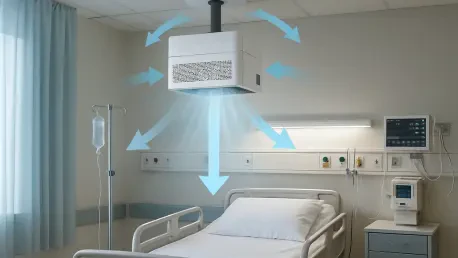In an era where respiratory illnesses and environmental health risks pose significant challenges to public health, the quality of air within hospital walls has never been more critical to patient and staff safety. Hospitals, as sanctuaries of healing, must contend with invisible threats like viruses, bacteria, and allergens that can linger in the air, potentially undermining the very care they provide. Addressing this pressing concern, Mayo Clinic, a renowned nonprofit healthcare leader based in Rochester, Minnesota, has embarked on a groundbreaking journey to transform indoor air safety. With substantial funding from the Advanced Research Projects Agency for Health (ARPA-H), this initiative promises to redefine how healthcare environments protect against airborne dangers, setting a new benchmark for patient care through cutting-edge technology and innovative research.
Pioneering Air Safety Through Innovative Research
Launching the HAIQU Project for Enhanced Patient Care
Mayo Clinic’s latest endeavor, known as Hospital Air Quality (HAIQU): Breathing Life into Patient Care, has secured up to $40 million from ARPA-H to spearhead advancements under the BREATHE program. This ambitious project targets the heart of healthcare environments by focusing on real-time monitoring and improvement of indoor air quality, particularly in high-risk areas like emergency departments. Spanning Mayo Clinic’s campuses in Florida, Arizona, and Minnesota, the initiative integrates advanced tools such as biosensors, artificial intelligence, and smart filtration systems. These technologies aim to detect harmful aerosols—ranging from viruses to mold—and respond automatically to mitigate risks. By prioritizing respiratory health and preventing the spread of airborne diseases, the HAIQU project reflects a deep commitment to safeguarding patients, staff, and visitors in spaces meant for recovery and healing.
Building the Hospital of the Future with Smart Technology
Beyond immediate detection, the HAIQU project envisions hospitals as intelligent, adaptive spaces that prioritize safety through data-driven solutions. Dr. Vijay Shah, Kinney Executive Dean of Research at Mayo Clinic, has emphasized the goal of creating resilient clinical systems capable of sensing and interpreting environmental data instantly. This forward-thinking approach is part of Mayo Clinic’s broader Bold. Forward. Unbound. initiative, which seeks to design flexible, clean environments optimized for healing. Under the leadership of Dr. Connie Chang, principal investigator and associate professor of biomedical engineering, the project pushes boundaries by focusing on illness prevention rather than reaction. The integration of state-of-the-art technology not only addresses current health risks but also sets a precedent for how healthcare facilities can evolve into safer, more responsive ecosystems over time.
Collaborative Efforts and Long-Term Impact
Harnessing Expertise Across Disciplines and Institutions
The strength of the HAIQU project lies in its collaborative framework, bringing together a multidisciplinary coalition of experts from healthcare, biotechnology, and academia. Partners include esteemed institutions like Princeton University, the University of Minnesota Twin Cities, and The University of Chicago, alongside industry innovators such as Siemens Corporation and Metalmark Innovations. Within Mayo Clinic, a diverse team of specialists, including Dr. Jim Wilking in biosensor engineering and Dr. Chung Wi in clinical validation studies, drives the research across multiple campuses. This synergy of perspectives ensures a comprehensive strategy to tackle the complex challenge of air quality in high-stakes hospital settings. By combining clinical insights with technological advancements, the project addresses both immediate needs and long-term goals for public health infrastructure.
Shaping Future Standards for Air Quality in Healthcare
Looking ahead, the HAIQU project, set to unfold over the next five years from now until 2030, is structured in three phases, beginning with biosensor development for detecting airborne contaminants in emergency rooms. Later stages will focus on real-world testing and validation, with the potential to influence national indoor air quality standards and public health policies. The anticipated outcomes include a scalable model for monitoring and intervention that other healthcare facilities can adopt. This initiative not only responds to growing concerns about respiratory illnesses but also highlights a broader need for systemic improvements in environmental health safety. By establishing a foundation for proactive, technology-driven measures, Mayo Clinic aims to leave a lasting impact, as the successful implementation of these systems in past phases paved the way for transformative changes in how hospitals protect against unseen threats. Moving forward, stakeholders must continue to prioritize investment in such innovations, ensuring that safer, healthier environments become the standard for patient care across the nation.









